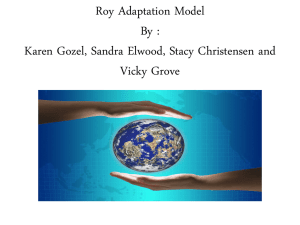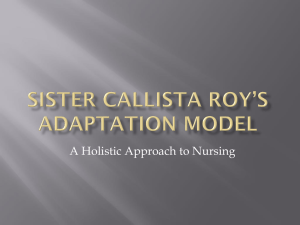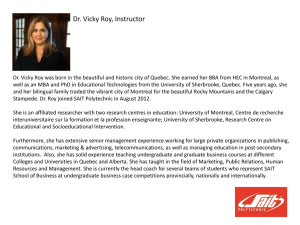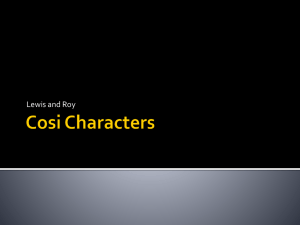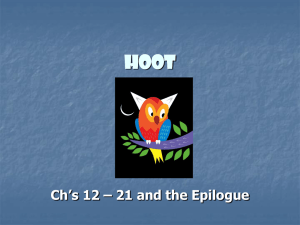Nursing Theorist Presentation
advertisement
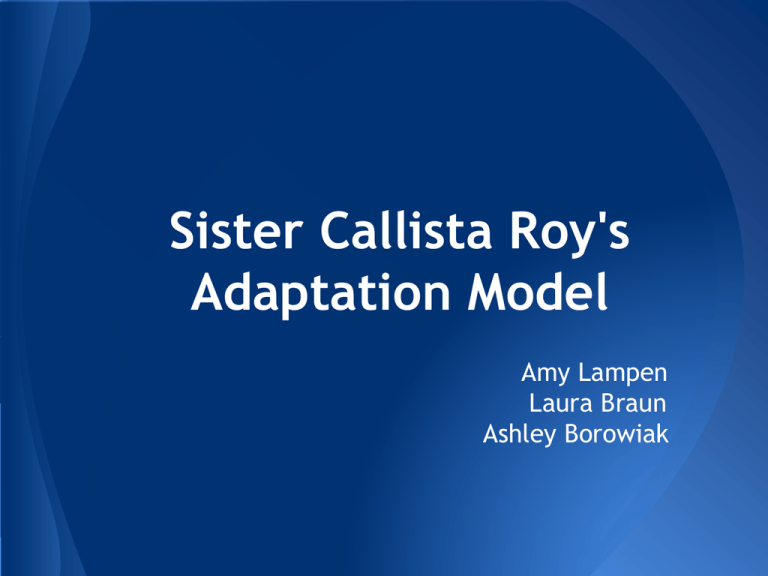
Sister Callista Roy's Adaptation Model Amy Lampen Laura Braun Ashley Borowiak Introduction Roy's Adaptation Model focuses on a person's coping (adaptive) abilities in response to a constantly changing environment (Lopes, Pagliuca, & Araujo, 2006). Nursing can promote effective coping by asking, "How can I modify this patient's environment to facilitate his adaptation?" (Chitty & Black, 2011, p. 311). Development of the Model • • • Roy believed that the environment and the individual are sources of stimuli that require modification to promote adaptation in the patient (Chitty & Black, 2011, p. 313). Health is defined as the process of achieving adaptation with the environment stimuli so the person is integrated and a whole (Shosha & Al kalaldeh, 2012). Adaptation is manifested by four interrelated modes of behavior including physiological, self-concept, role function and interdependence modes. Roy's values on nursing and knowledge development • Awhen person’s behavioral responses are ineffective for coping the demands of the environment are too high or the • • person’s adaptive resources are too low (Chitty & Black, 2011, p. 313). Nursing goals are to promote adaptation for individuals contributing to health, quality of life, and dying with dignity. Nurses need to assess patient behavior and factors that influence adaptive abilities. By doing this, nurses can plan interventions to expand abilities to adapt and enhance environmental interactions (Connell School of Nursing, 2010). What influenced Roy's Adaptation Model? According to Debra R. Hanna (2013), "Roy's specific life values included, among others, her Roman Catholic religious beliefs, her commitment to living as a consecrated religious Sister of St. Joseph of Cardondelet, and belonging to a religious order that derives its rule from the spirituality of St. Ignatius of Loyola, founder of the Society of Jesus (also known as the Jesuites)" (p. 53). Hanna (2013) also states that "It is no coincidence that Modras's description of Ignatian humanism is consistent with Roy's description of humanism, which differs in a major way from the contemporary, secular approach to humanism. Also Roy (1997) has mentioned having been influenced by the posthumous writings of another Jesuit priest, the late Reverend Pierre Teilhard de Chardin (1881-1955) (p. 53). Influences on Roy's theories (cont'd) Roy had worked in a pediatric unit and was impressed with the resiliency of the children she cared for. Having little knowledge on the concept of adaptation and with much encouragement, she developed her concepts and theories to form a popular framework in nursing today (Connell School of Nursing, 2010). Concepts of Roy's Adaptation Model Roy's Adaptation Model includes the main four global concepts of nursing but also adds one more. Her model includes the person which is the adaptive system, the environment which is the stimuli to the person, health which revolves around the outcome of the person's ability to adapt to the stimuli, nursing which is us promoting the persons adaptation and health and lastly adaptation which is the main goal of nursing. Roy's Model and it's Influences on the Global Concepts Human being: The person must learn to adapt by being consciously aware and use choice in order to integrate their condition with their environment with the help of nursing. Environment: Three kinds of stimuli exist in the environment including focal, contextual and residual. All conditions, circumstances and influences surrounding a person affect their healing process and the development and behavior of a person. According to Roy, having a healthy environment for the patient is key for healing. Health: The health of a person relies heavily on the state of their environment and their ability to adapt to it. Roy defines health as “a state and process of being and becoming integrated and whole that reflects person and environmental mutuality.” Nursing: Nursing is a science which expands adaptive abilities in patients and enhances the transformation in person and environment through assessment, diagnosis, goal setting, intervention and evaluation. Interpretation and Inference • In the 1970's, Roy's publication presented the concept of environment as being limited to place. o Roy further defined the concept of environment by making several revisions after her first publication • Humanism is a term often used in the discipline of (Lopes et al., 2006) nursing, but it has not been firmly defined in a single way by nurse scholars. o Roy's view of humanism is tied to her own values based on her life experience. (Hanna, 2013) Implications and Consequences • "Although the model originated in the United States, scholars who now use the Roy adaptation model come from the global community" (Roy, Whetsell, & Frederickson, 2009, p. 209). • "Publications in various journals sought to • contribute to the understanding and application of her model" (Lopes et al., 2006). Nurses, who were educated about the concepts prior to implementing "the Roy Model in their practice, felt that their professionalism was enhanced" (Weiss, Hastings, Holly, & Craig, 1994). Is Roy's Adaptation Model unique? Roy's adaptation model is a unique model that "is widely used for education, research, and nursing practice today (Chitty & Black, 2011, p. 313)." This is the only model that is "focused on the individual as a biophysical adaptive system and described nursing as a humanistic discipline that emphasizes the person's adaptive or coping abilities (Chitty & Black, 2011, p. 313)." Does this model have a narrow view? "Sister Roy continues to update, revise, and refine it for use in practice, research, theory, and administration" (Chitty & Black, 2011, p. 313). According to Pamela Senesac (2013), a nurse with a doctorate degree at Boston College where Roy is also a professor and nursing theorist, Roy’s model is being actively used in the following areas in addition to many more: A NICU as an ideology for nursing An acute surgical ward as a means of documenting compliance with the nursing process In an 18-bed unit in a rehab facility o integrate the professional basis of patient care In a 125-bed orthopedic hospital to facilitate an integrated system of nursing In a 145-bed hospital to increase clarity in provider roles and to strengthen interdisciplinary collaboration and effectiveness • • • • • Practice Situation Chitty & Black (2011), describe a situation with a patient that is receiving home care by a nurse for a wound. Once the wound is non-resolving the nurse further investigates using Roy's Adaptation Model and by asking questions based on the thought process of RAM. From his assessment, he discovered that the patient needed to be tested for diabetes. The nurse was able to see the environmental stimuli that was negatively affecting the patient's healing process and further intervene. Case Study A seventy-nine year old man, with a history of congestive heart failure (CHF), lost his wife last year and now lives alone. His wife used to cook all of his meals and manage his medications for him. He still remains social with his friends, meeting them for coffee and breakfast each morning. He enjoys being outdoors and reading, though his eye sight has diminished lately, and he is embarrassed to share this with his children. While he maintains his appointments with his physician, the patient has had an increasing number of hospital admissions related to CHF and often waits until his symptoms are severe before seeking medical attention. His lasix are scheduled BID and he does not like taking his night time dose because he is up all night urinating. Though he has children who are active in his care, they are busy taking care of their own children. His daughter drops in to check on him a few times a week, bringing him dinners that she has frozen for him to eat throughout the week. For lunch or sometimes dinner, the patient will have a can of soup and enjoys drinking things such as gatorades and juices. Using what you have learned from the presentation and your textbook, complete an assessment on the patient’s environment. What conclusions can you reach as to why the patient's condition is worsening? What type of interventions would you then complete? References Chitty, K.K., & Black, B.P. (2011). Professional nursing: Concepts and Challenges (6th ed.) Maryland Heights, MO: Saunders. Connell School of Nursing (2013). The Roy adaptation model. Boston College William F. Connell School of Nursing. Retrieved from http://www.bc.edu/content/bc/schools/son/faculty/featured/theorist/Roy_Adap tation_Model.html Current Nursing.(2012, January 26). Nursing Theories. In Roy's Adaptation Model. Retrieved from http://currentnursing.com/nursing_theory/Roy_adaptation_model.html Hanna, D.R. (2013). Roy's Specific Life Values and the Philosophical Assumption of Humanism.Nursing Science Quarterly, 26(1), 53-58. doi: http://0dx.doi.libcat.ferris.ed/10.1177/0894318411419210 References cont. Lopes, M., Pagliuca, L., & Araujo, T. (2006, March). Historical evolution of the concept environment proposed in the Roy Adaptation Model. Revista LatinoAmericana de Enfermagem, 14(2), 259-265. doi:10.1590/S010411692006000200016 Roy, C., Whetsell, M., & Frederickson, K. (2009, July). The Roy Adaptation Model and research. Nursing Science Quarterly, 22(3), 209-211. doi:10.1177/0894318409338692 Senesac, Pamela (2013). Implementing the Roy adaptation model: From theory to practice. Retrieved from http://www.bc.edu/content/bc/schools/son/faculty/featured/theorist/Roy_ Adaptation_Model/Practice.html Shosha, G.A., Al kalaldeh, M. (2012). A critical analysis of using roy’s adaptation model in nursing research. International Journal of Academic Research, (4)4, 2631. Weiss, M. E., Hastings, W. J., Holly, D. C., & Craig, D. I. (1994). Using Roy's adaptation model in practice: nurses' perspectives. Nursing Science Quarterly, 7(2), 80-86. doi:10.1177/089431849400700208
